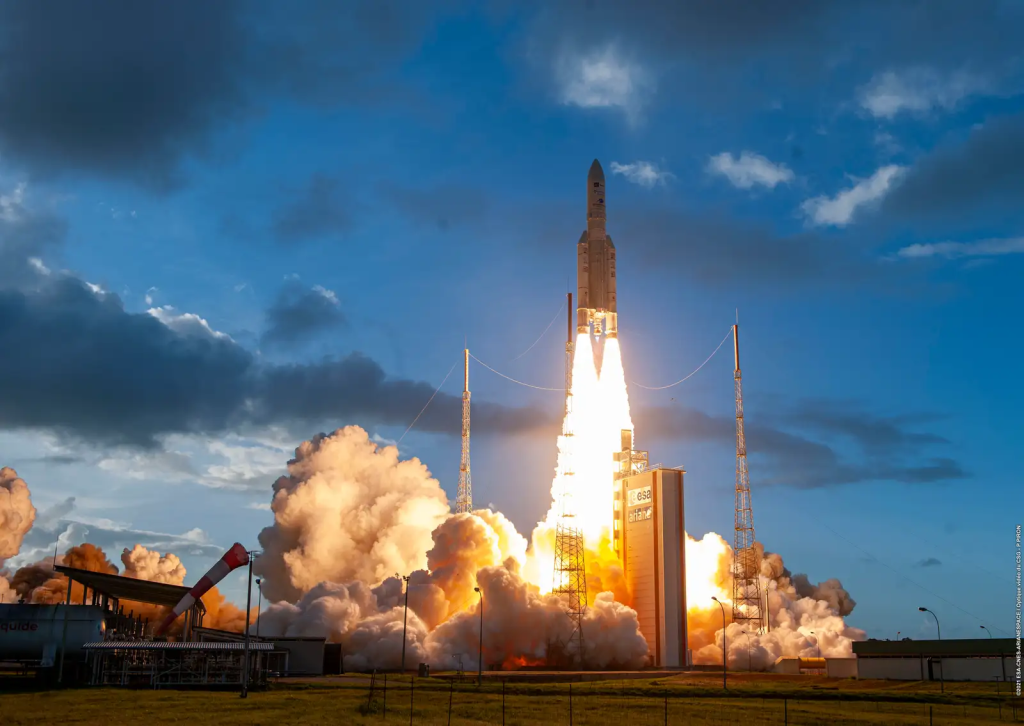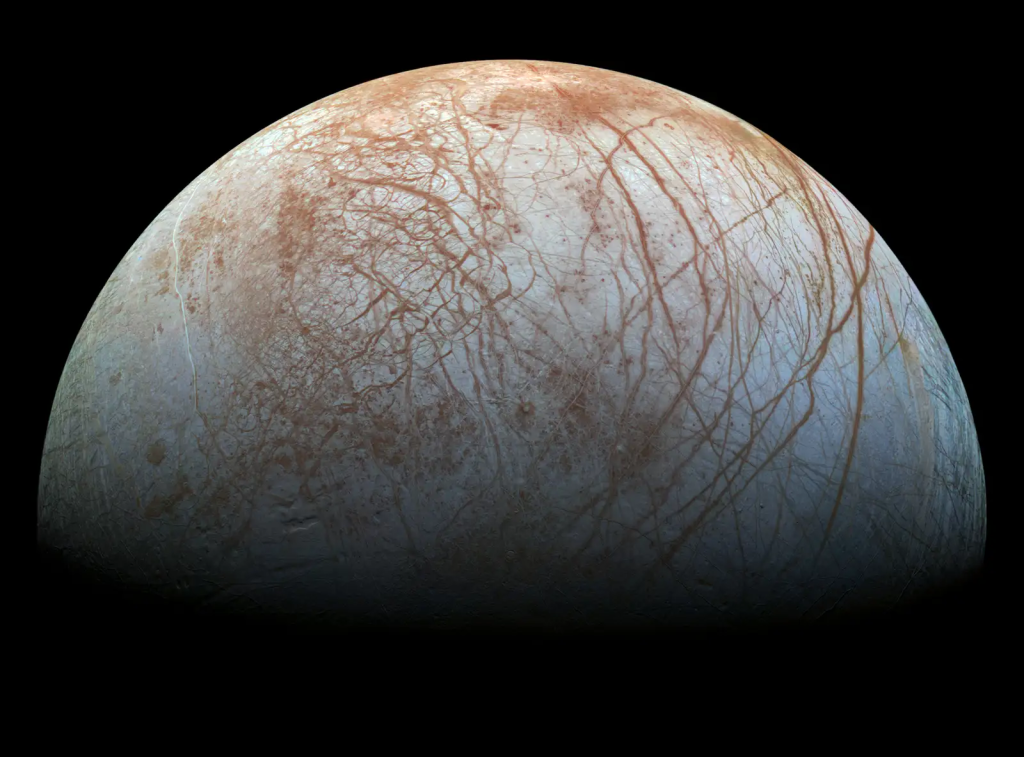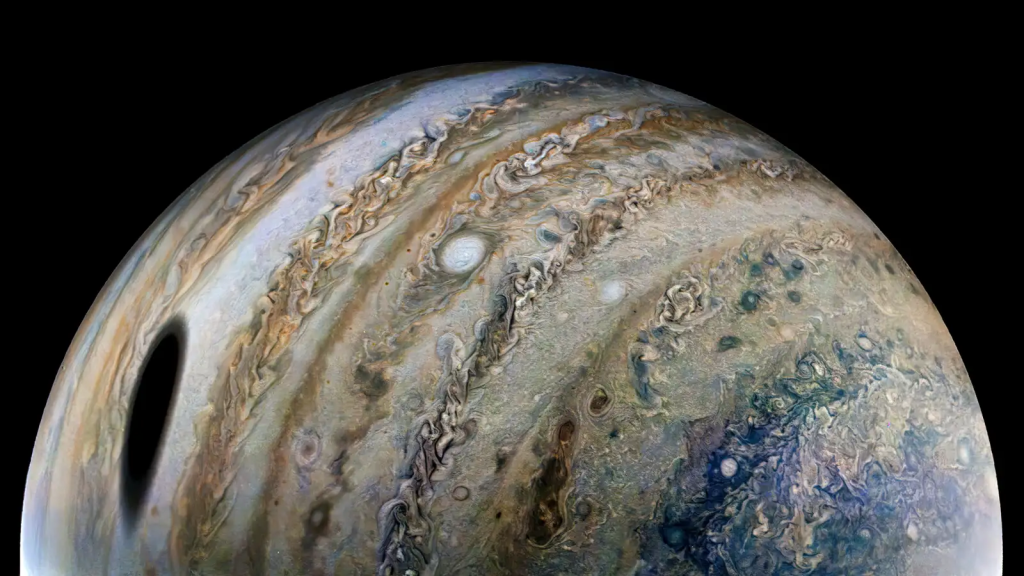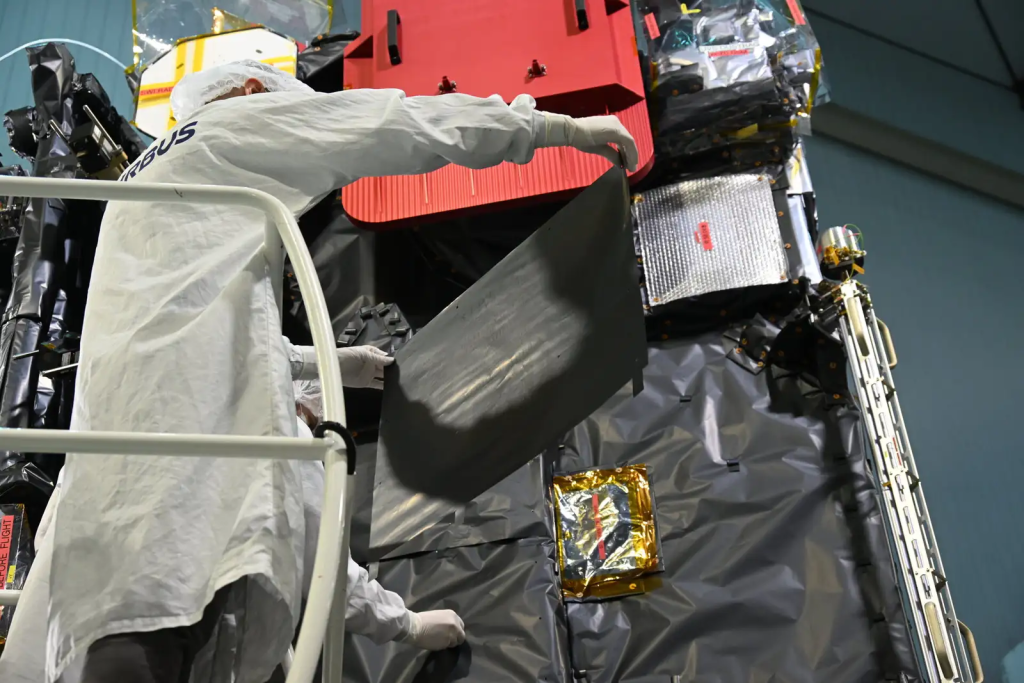Over a decade since its announcement, the European Space Agency’s (ESA) Jupiter Icy Moons Explorer (JUICE) is ready to embark on its groundbreaking journey to the giant gas planet. Scheduled for launch on April 13, JUICE is equipped with 10 cutting-edge instruments designed to delve deep into the mysteries of the outer solar system. This historic mission promises to shed new light on Jupiter and its captivating moons.
Although NASA’s Juno spacecraft has been studying Jupiter for seven years, its mission is expected to end in 2025. Currently, NASA’s Lucy probe is en route to Jupiter’s orbit, but it is primarily focused on the Trojan asteroids rather than the gas giant itself. This leaves a potential gap in our direct exploration of Jupiter and its moons. However, the upcoming launches of NASA’s Europa Clipper and ESA’s JUICE will ensure continued investigation into this intriguing planetary system.
JUICE’s primary mission is to explore Jupiter’s three icy moons—Ganymede, Callisto, and Europa—each harboring the potential for subsurface oceans and, possibly, extraterrestrial life. The spacecraft’s advanced suite of instruments will enable scientists to scrutinize the moons’ geological features, magnetic fields, and atmospheric compositions. Moreover, JUICE will conduct detailed observations of Jupiter’s atmosphere, magnetosphere, and auroras, enhancing our understanding of the gas giant’s complex dynamics.
As one of the most sophisticated probes ever dispatched to the outer solar system, JUICE represents a significant leap forward in space exploration. Its findings will not only revolutionize our knowledge of Jupiter and its icy moons but also contribute to the broader understanding of planetary formation and evolution. The countdown to JUICE’s historic launch has begun, and the scientific community eagerly awaits the new discoveries that lie ahead.

JUICE, the European Space Agency’s ambitious mission to explore Jupiter’s icy moons, is about to embark on its momentous journey to the gas giant. The spacecraft will primarily focus on three of Jupiter’s more than 70 natural satellites: Europa, Ganymede, and Callisto. These intriguing moons, known as the Galilean moons (along with the volcanic Io), are believed to harbor vast amounts of subsurface water concealed beneath their icy exteriors.
An international collaboration spearheaded by the European Space Agency, JUICE will spend approximately three to four years in the Jovian system. During this time, the spacecraft will execute multiple flybys and conduct in-depth observations of Europa, Ganymede, and Callisto, as well as their immediate environments. These investigations will offer valuable insights into the moons’ geological features, magnetic fields, atmospheric compositions, and the potential existence of subsurface oceans.
By studying these icy moons, scientists hope to not only uncover clues about the conditions necessary for life but also to gain a deeper understanding of the formation and evolution of planetary systems. As JUICE prepares for its pioneering mission, the global scientific community eagerly anticipates the wealth of discoveries that await in the mysterious realm of Jupiter and its icy satellites.

An Arianespace Ariane 5 rocket has been entrusted with launching the $1.6 billion probe. Blastoff is set for 8:15 a.m. ET on April 13 from Europe’s Spaceport in French Guiana. The mission, known as VA260, will be Arianespace’s 30th scientific mission and the 116th launch of Ariane 5 overall, according to the company. JUICE will be Europe’s first mission to the Jovian system. Once freed from the rocket’s payload fairing and Earth’s gravitational field, the 6-metric-ton JUICE will race away at speeds reaching 1.6 miles per second (2.5 kilometers per second).The $1.6 billion JUICE probe is set to be launched aboard an Arianespace Ariane 5 rocket on April 13 at 8:15 a.m. ET from Europe’s Spaceport in French Guiana. Designated as mission VA260, this launch marks Arianespace’s 30th scientific mission and the 116th overall launch of the Ariane 5 rocket, as stated by the company. This momentous event will also be Europe’s first mission to the Jovian system.
Once the spacecraft is successfully released from the Ariane 5 rocket’s payload fairing and has escaped Earth’s gravitational pull, the 6-metric-ton JUICE probe will accelerate to impressive speeds of up to 1.6 miles per second (2.5 kilometers per second). This incredible velocity will propel the probe on its long-awaited journey to explore Jupiter and its intriguing icy moons, ultimately paving the way for groundbreaking discoveries and a deeper understanding of the Jovian system.

Europa, Ganymede, and Callisto are all believed to host subsurface oceans beneath their icy crusts, making them prime targets for JUICE’s exploration. The mission aims to assess the habitability potential of these moons, given the assumed presence of liquid water. As outlined by ESA, the overarching question driving the mission is whether gas giants and their moons can foster habitable conditions and support primitive life forms.
In addition to its astrobiological investigations, JUICE will also seek to answer questions related to planetary formation and the broader understanding of the solar system. By studying the Jupiter system, the spacecraft will provide valuable insights into the characteristics and dynamics of gas giants both within our solar system and across the Universe.
ESA’s ambitious mission, therefore, not only aims to unlock the mysteries of Jupiter and its icy moons but also seeks to expand our understanding of the diverse range of planetary systems that exist throughout the cosmos. As the probe embarks on its groundbreaking journey, the scientific community eagerly awaits the wealth of knowledge that JUICE will bring back about Jupiter, its moons, and the nature of gas giants in the Universe.

Throughout its mission, JUICE is slated to perform 35 flybys of the Jovian moons, but the spacecraft’s ultimate destination is Ganymede. The probe will settle into a circular orbit around this massive moon, coming as close as 311 miles (500 km) to its surface while conducting operations for an estimated six months. According to ESA, JUICE will be the first spacecraft to ever orbit a moon in the outer solar system, marking a significant milestone in space exploration.
Ganymede is an ideal target for this historic achievement, as it is not only the largest moon in the solar system but also the only known moon to possess its own magnetic field. This unique feature causes Ganymede to interact with the Jovian environment in distinctive ways, offering scientists a rare opportunity to study the moon’s geophysical properties and its relationship with Jupiter. As JUICE ventures into the uncharted territory of Ganymede’s orbit, it promises to provide invaluable insights into the complexities of the Jovian system and the broader understanding of celestial bodies in the outer solar system.

ESA greenlit the JUICE mission in 2012 as an integral component of its Cosmic Vision science program. Airbus Defence and Space was responsible for constructing the probe, which is equipped with an 8.2-foot-long (2.5-meter) high-gain antenna and 10 solar panels. Once deployed, the solar panels will span a total of 915 square feet (85 square meters), making it the largest array ever utilized for an interplanetary mission, as stated by ESA.
Despite the considerable distance from the Sun, these solar panels will generate 850 Watts of power, efficiently fueling the spacecraft and its instruments throughout its mission. JUICE’s advanced design, including its state-of-the-art power system, will enable the probe to conduct extensive observations and analyses of Jupiter and its icy moons, furthering our understanding of these enigmatic celestial bodies and their potential to harbor life.

JUICE’s 10 carbon fiber-reinforced honeycomb panels are designed to unfold once the spacecraft reaches space, forming two cross-like shapes on either side of the probe. Approximately 50 minutes after launch, the two solar arrays will deploy in a process expected to take around one minute. These solar arrays will play a crucial role in powering the spacecraft throughout its mission.
The medium-gain antenna, set to emerge 16 hours into the mission, will serve multiple purposes. It will be used during the flybys of the moons and will also establish a communication link between the probe and Earth-based controllers when the spacecraft’s larger antenna is functioning as a sunshield. This efficient design ensures that JUICE can maintain consistent communication with mission control while simultaneously protecting its delicate instruments from the Sun’s heat, enabling the probe to carry out its groundbreaking research on Jupiter and its icy moons.

JUICE boasts an impressive array of 10 instruments, which ESA asserts make up the “most powerful remote sensing, geophysical, and in situ [sensors for gathering data in JUICE’s immediate environment] payload complement ever flown to the outer Solar System.” This diverse suite of tools was developed through the collaborative efforts of NASA, ESA, and Japan’s space agency.
The instruments on board JUICE possess a wide range of capabilities, including optical and spectral imaging, sensors for examining the moons’ surface and subsurface features, and devices for measuring magnetic fields as well as radio and plasma waves. This comprehensive set of tools will enable the spacecraft to conduct in-depth analyses of Jupiter, its icy moons, and their surrounding environments, providing invaluable insights into their geology, atmospheric composition, and potential habitability. As JUICE embarks on its pioneering mission, the scientific community eagerly anticipates the wealth of discoveries that these advanced instruments will unveil in the outer solar system.

JUICE’s highly advanced cameras are designed to capture stunning details of the moons’ features while identifying the various ices and minerals on their surfaces, as highlighted by ESA in its press kit. The spacecraft’s other instruments will probe the subsurface and interiors of the moons to gain a deeper understanding of the location and nature of their hidden oceans. Additionally, JUICE will explore the thin atmospheres surrounding these moons.
Alongside its suite of instruments, JUICE is carrying a science experiment that takes advantage of the probe’s communication system and its interaction with ground-based telescopes on Earth. This experiment will assist mission controllers in accurately determining the spacecraft’s position and velocity during its journey through the Jovian system. The combination of cutting-edge instruments and innovative experiments will enable JUICE to conduct groundbreaking research and uncover new insights into Jupiter and its icy moons, advancing our understanding of these enigmatic celestial bodies.

In tribute to Italian astronomer Galileo Galilei, who made the groundbreaking discovery of Jupiter’s four largest moons through a telescope in 1610, ESA has prepared a commemorative plaque for the JUICE mission. This special plaque features imagery of Galilei’s initial observations of Jupiter, as documented in his renowned manuscript, Sidereus Nuncius.
Galileo’s pioneering work laid the foundation for our understanding of Jupiter and its fascinating moons. By incorporating a tribute to his historic discovery, ESA honors the legacy of this influential astronomer and the spirit of scientific curiosity that drives space exploration. As JUICE embarks on its journey to unravel the mysteries of Jupiter and its icy moons, it carries with it the rich history of astronomical discoveries that have shaped our understanding of the cosmos.

Jupiter is indeed the focus of significant scientific interest at the moment, with JUICE being one of three planned missions to the gas giant, including Lucy and NASA’s Europa Clipper. The latter is scheduled for launch in October 2024, and as NASA program scientist Curt Niebur explained in a 2017 statement, the two missions will work in synergy. “The missions are like close members of the same family. Together they will explore the entire Jovian system,” he elaborated.
While Europa Clipper’s primary objective is to study Europa and assess its habitability, JUICE aims to gain a broader understanding of how the entire group of Galilean satellites formed and evolved. The Europa Clipper is anticipated to arrive at Jupiter in April 2030. By combining the efforts of these complementary missions, scientists will be able to piece together a more comprehensive picture of the Jovian system, furthering our knowledge of Jupiter, its moons, and their potential to support life.







